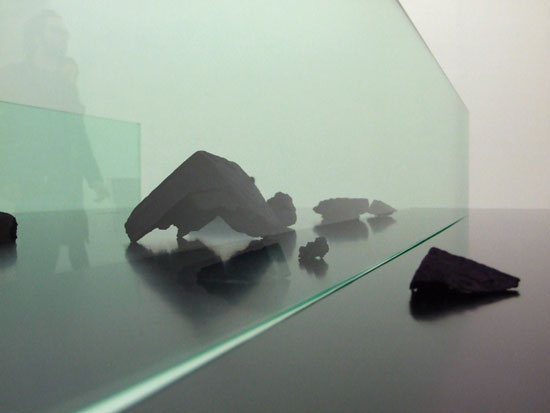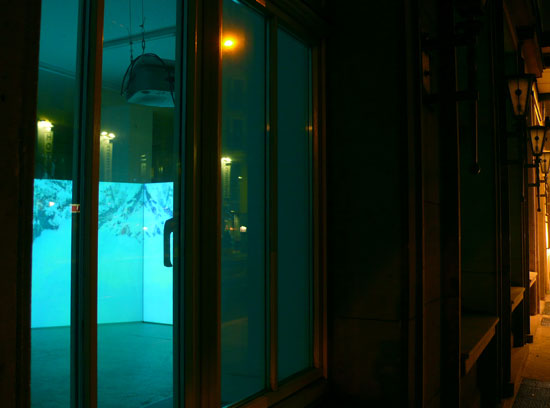Loci of Agglomeration and Spatial Dynamics
on Mladen Bizumic’s installations How If – A Translation in III Acts
Marc Glöde

We often only realize that the museum is an apparatus that regulates our perception of art when the process of our reception is interrupted – like when the flow of the walk through the museum or gallery is broken by an encounter with an installation, for example.
How if – A Translation in III Acts, the installation group by Mladen Bizumic, offers such a possibility for interruption, taking a stalwart position against exhibition practices that concretize and delimit (spatial) thinking. Already, the splitting of the work in two different locations goes against the conventional spatial practices of art presentation. As the tripartite work is not limited to one space of installation, but is in fact dislodged from the architectonic and institutional parameters of a single space, it escapes from the constrictions of the interior space, and out from a position of self propelled monopoly. Meanwhile, the simple splitting of the exhibition in two locations creates an in-between space that gives access to the urban structure surrounding the pieces – the installation requires the visitor’s movement through the city to be fully experienced. Art, for Bizumic, becomes a space that is no longer fully separated from the everyday sphere, and in fact, acts as a counterpart that can and should always be related to the everyday.1 The relationship between the pieces acts as a parallel to the correspondence between the two locations of the exhibition, opening a debate between their different spatial dynamics.
Act I + II

The work of the first and second acts appears as little islands, seemingly arranged in clusters within the room. The pieces are various cooperations between Bizumic and people in his personal circles. In the video installation Sister Cities of Berlin (Paris), an abstract light-play seen through a glass door and enriched with ambient sounds composed by MINIT, the viewer/listener is abducted to an in-between space. Freud Museum (For Her) – second of three acts, is a display that oscillates between sculpture and vitrine in which black colored stone fragments from buildings in Vienna are exhibited. This arrangement is accompanied by two commissioned works: a piano piece composed by the artist’s Viennese girlfriend (a musician) and a ‘psychoanalytical poem’ written by his mother (a psychoanalyst). These are pieces that, taken individually, not only possess the potential to summon us away to other places, but they demand that we “Leave the presence for a moment....” But it is precisely this Für-sich-Nehmen, this problem of the isolated, contemplative perception of the single element that Bizumic seeks to problematize. As the questions and stories opened by each piece constantly interfere with the other positions present in the space, Bizumic shows how quickly new interpretations and approaches are created from the disparate self-contained positions. Like in a laboratory (which the space with its white fluorescent lights reminds one of) the viewers can thoroughly observe themselves in a process that could be described as a production of meaning and mood. These installations, these discrete agglomerations expose themselves increasingly as space consuming axes from which “mystery/story and hystery and his(s)tory”2 are amplified. They’re in constant modification, determining the experience of the viewer in the space. At the same time, the fragments in the installation never gain enough power to link together into a continuous narrative or homogeneous whole – one would never be able to form a black square from the installation’s black fragments. By remaining fragment-like, these single pieces bring up analytical questions: how does the sound piece change when layered over the text on the wall? How does this change my disposition/mood? How does the surrounding architecture affect this? What relationships and dynamics are created by the use of black in the various pieces in the same space?
Act III
The third act of the installation, housed at a different location, eventually brings our attention to one of the spatial discourses that have strongly influenced the recent art context: namely the discourse around the filmic Dispositiv and its implementation in the art space. Where, in the end of the 1960s, the filmic apparatus was subject to strong criticism by Baudry because of its spatial determination3, the apparatus in Bizumic’s work is clearly not a machine that defines the viewer’s apperception. An L-shaped wall is installed in the gallery and serves as a projection surface for two mirrored projections. This mirroring along the fold of the wall transforms each double projection not only into a big ornament, but also into something of a constantly changing Rorschach inkblot. In this way, the filmic projection stops being a mode of representation and enters a play with one’s own projections of the unconscious. By pointing out the interweaving of image-space, architectonic-space and mental-space, Bizumic opens up the possibility of a critique of the apparatus and the institution. These are positions that “open themselves towards their visible and invisible contexts in a literal way, and in doing so they explicitly address them.”4 Mladen Bizumic’s installation thus positions itself clearly against a practice of directing movement, mental and physical, and produces a stutter, a discontinuity in the art-space. This disconnect does not only allow for immediate questions to emerge in reference to the form used in the installation; Bizumic reveals factors like one’s own body, the architecture, the staging as well as the complex merging of these aspects that have dropped out of the frame in the continuity editing of the museum and galleries experience. So its no longer enough to rely on Adorno’s observations, that the reception of a work of art is always bound inseparably with the experience of space and “with its ambient, its value, its place both literally and metaphorically.”5 In How If..., Bizumic shows that approaching the potentials of the space means to not take for granted the relationships between space, the art work, and the viewer, nor to deal with it as a cliché, but rather to calibrate this constellation again and again towards its internal dynamics.

1 Foucault, Michel. Andere Räume. in Barck, Gente, Paris, Richter (ed.), ‘Aisthesis. Wahrnehmung heute oder Perspektiven einer anderen Ästhetik.’ Leipzig 1990. p34-46.
2 Blumfeld. Verstärker, from ‘L’etat et moi,’ Big Cat Recording, London 1994.
3 see Baudry, Jean-Louis. Ideologische Effekte erzeugt vom Basisapparat. in ‘Eikon. Internationale Zeitschrift für Photographie und Medienkunst’, Nr. 5, 1993, S. 34-43.
4 Rebentisch, Juliane. Ästhetik der Installation, Frankfurt a.M. 2003, p232.
5 Adorno, Theodor W. Ästhetische Theorie, in ‘Gesammelte Schriften’, vol.7, edited by R. Tiedemann, Frankfurt a.M. 1970, p520.
Marc Glöde is Assistant Professor & Research Fellow in the Department of Film Studies at the Free University, Berlin. He has curated numerous exhibitions and film-series on film/art and film/architecture and has published widely within the fields. He was recently curator at the Experimenta Filmfestival in Mumbai/Bangalore, at the exhibition “What a great space you have” at Luxe Gallery, NYC and co-curator of the film series “Beyond the Cinema” together with Stan Douglas, Chris Eamon and Stefanie Schulte-Strathaus at the Hamburger Bahnhof/Cinema Arsenal. He is the Co-Director of the Wild Walls Film Festival (Berlin, Los Angeles, London and New York). His latest publication is “Igor Mischiyev: MultistoryCarPark”. He is currently based in Berlin and New York City.
Translated by Carson Chan, Fotini Lazaridou-Hatzigoga and Alexander Menke.